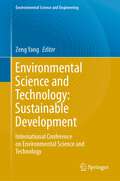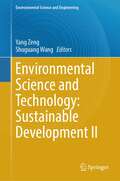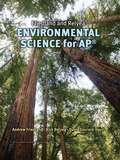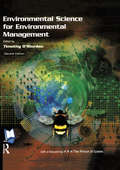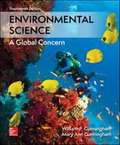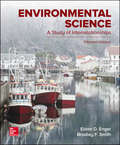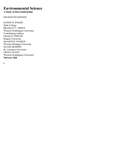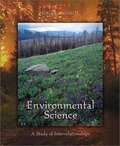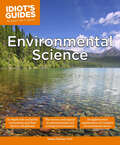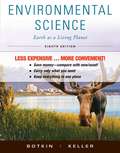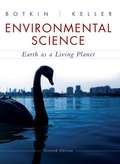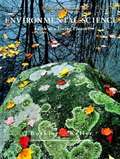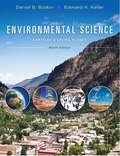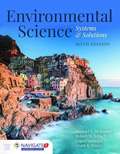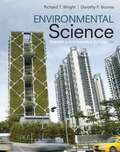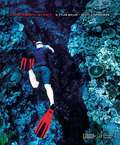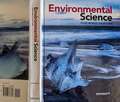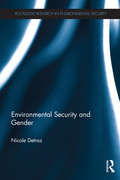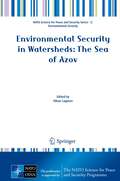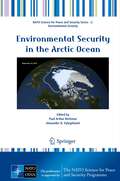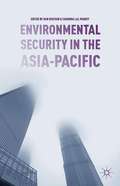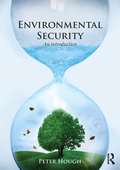- Table View
- List View
Environmental Science and Technology: International Conference on Environmental Science and Technology (Environmental Science and Engineering)
by Zeng YangThis book features a collection of high-quality and peer-reviewed papers from 2022 13th International Conference on Environmental Science and Technology, which was held in Shandong, China, during October 21–23, 2022. ICEST is held annually as a platform for presentation of new advances and research results in the fields of Environmental Science and Technology. This year, we focus on the theme: Environmental Protection and Sustainable Development. With the continuous development of human society, environmental problems are becoming more and more serious. How to realize the rational use of resources, realize the sustainable development of ecological environment, and protect the environment on which human beings live has become an urgent problem to be solved. Based on the conference theme this year, the presentations include the topical areas of environmental sustainability, environmental restoration, waste minimization, solid waste management, water pollution control, water treatment and reclamation, air pollution control, carbon capture and storage and environmental monitoring, etc.
Environmental Science and Technology: Sustainable Development II (Environmental Science and Engineering)
by Shuguang Wang Yang ZengThis book features a collection of high-quality and peer-reviewed papers from 2023 14th International Conference on Environmental Science and Technology, which was held in Shandong, China, during November 23–25, 2023. ICEST is held annually as a platform for presentation of new advances and research results in the fields of Environmental Science and Technology. With the continuous development of human society, environmental problems are becoming more and more serious. Recently, we face some difficult problems such as: global climate change, ozone layer destruction and depletion, acid rain pollution, desertification, and water resources crisis. Based on the theme this year, the presentations include the topical areas of environmental sustainability, waste minimization, solid waste management, water pollution control, water treatment and reclamation, air pollution control, carbon capture and storage and environmental monitoring, etc.
Environmental Science class 10 - ICSE Board
by Dr Kalpana GuptaA Textbook of I.C.S.E. Environmental Science for Class X has been especially written to comply with the norms set by the Council for the Indian Certificate of Secondary Education (ICSE) Examinations, New Delhi and it strictly conforms to the Syllabus prescribed by Council for the year 2023 and onward examinations. This book emphasizes meaningful learning of Environmental Science and the overall development of learners. It focuses on helping children to understand their natural environment and correlate science with their everyday experiences in an interesting and comprehensive manner.
Environmental Science for AP
by Andrew Friedland Rick Relyea David Courard-Hauri<p>Friedland/Relyea Environmental Science for AP was written specifically for the AP Environmental Science (APES) course, directly addressing the needs of APES students and teachers from beginning to end. Lead author Dr. Andrew Friedland of Dartmouth College was the founding Chair of the College Board committee that created the APES course. He regularly teaches Introduction to Environmental Science at Dartmouth and is actively researching environmental science topics related to air pollution and carbon accumulation in forests. <p>The Friedland package uniquely prepares students for the quantitative aspects of the APES course in a way no other text does. In addition, it explores and explains every topic within the APES course description while offering a scientific and balanced approach to the key concepts. <p>The Friedland text is praised for its accessibility and for familiarizing students with the findings that inform environmental decision making at all levels--from personal choice to national and international policy. </p>
Environmental Science for Environmental Management
by Timothy O'RiordanEnvironmental Science for Environmental Management has quickly established itself as the leading introduction to environmental science, demonstrating how a more environmental science can create an effective approach to environmental management on different spatial scales. Since publication of the first edition, environmentalism has become an increasing concern on the global political agenda. Following the Rio Conference and meetings on population, social justice, women, urban settlement and oceans, civil society has increasingly promoted the cause of a more radical agenda, ranging from rights to know, fair trade, social empowerment, social justice and civil rights for the oppressed, as well as novel forms of accounting and auditing. This new edition is set in the context of a changing environmentalism and a challenged science. It builds on the popularity and applicability of the first edition and has been fully revised and updated by the existing writing team from the internationally renowned School of Environmental Science at the University of East Anglia.Environmental Science for Environmental Management is an essential text for for undergraduate students of environmental science, environmental management, planning and geography. It is invaluable supplementary reading for environmental biology and environmental chemistry courses, as well as for engineering, economics and business studies.
Environmental Science: A Global Concern
by William P. Cunningham Mary Ann CunninghamEnvironmental Science: A Global Concern is a comprehensive presentation of environmental science for non-science majors which emphasizes critical thinking, environmental responsibility, and global awareness. This book is intended for use in a one or two-semester course in environmental science, human ecology, or environmental studies at the college or advanced placement high school level. As practicing scientists and educators, the Cunningham author team brings decades of experience in the classroom, in the practice of science, and in civic engagement. <P><P>This experience helps give students a clear sense of what environmental science is and why it matters in this exciting, new 14th edition. <P><P>Environmental Science: A Global Concern provides readers with an up-to-date, introductory global view of essential themes in environmental science. The authors balance evidence of serious environmental challenges with ideas about what we can do to overcome them. An entire chapter focuses on ecological restoration; one of the most important aspects of ecology today. Case studies in most chapters show examples of real progress, and “What Can You Do?” lists give students ideas for contributing to solutions.
Environmental Science: A Study of Interrelationships
by Bradley F. Smith Eldon D. EngerThis environmental science text is known for being concise, conceptual, and value-priced. The approach and reading level cover the basic concepts without overloading students with too much detail. The authors reinforce the text's central theme of "interrelationships" by providing a historical perspective, information on economic and political realities, discuss the role of different social experiences, and integrate this with the crucial science to describe the natural world and how we affect it.
Environmental Science: A Study of Interrelationships
by Bradley F. Smith Eldon D. EngerEnvironmental Science: A Study of Interrelationships is a full-color, introductory environmental science text that is known for being concise, conceptual, and value-priced. The approach and reading level cover the basic concepts without overloading students with too much detail. <p><p>The authors reinforce the text's central theme of "interrelationships" by providing a historical perspective, information on economic and political realities, discuss the role of different social experiences, and integrate this with the crucial science to describe the natural world and how we affect it.
Environmental Science: A Study of Interrelationships Eighth edition
by Bradley F. Smith Eldon D. EngerEnvironmental Science is an interdisciplinary field. Because environmental disharmonies occur as a result of the interaction between humans and the natural world, we must include both when seeking solutions to environmental problems.
Environmental Science: An In-Depth Look at Earth’s Ecosystems and Diverse Inhabitants (Idiot's Guides)
by James DaurayEnvironmental science is an integrated, interdisciplinary field that combines the study of ecology, physics, chemistry, biology, soil science, geology, atmospheric science, and geography. It is among the top 10 most popular Advanced Placement examinations taken by high school seniors in an effort to receive postsecondary college credit. Idiot's Guides: Environmental Science provides a step-by-step review of the disciplines that comprise environmental science, helping students grasp the basic concepts, internalize the information, and prepare for exams. Features include: The basics and history of the human relationship with the natural environment. The ways species grow, change, and interact. A detailed description of the earth's ecosystems, including deserts, grasslands, forests, and aquatic ecosystems. The effects of economics and agriculture on the environment. The various types of energy humans use, as well as how its production impacts the earth's ecosystems, with a focus on renewable energy sources. The ill effects of a growing population, including pollution, toxins, bacteria, waste, and global warming/climate change.
Environmental Science: Earth As A Living Planet 8th Ed
by Daniel B. Botkin Edward A. KellerEnvironmental Science: Earth as a Living Planet, Eighth Edition provides emphasis on the scientific process throughout the book gives readers the structure to develop their critical thinking skills. Updated and revised to include the latest research in the field, the eighth edition continues to present a balanced analytical and interdisciplinary approach to the field. New streamlined text clears away the "jargon" to bring the issues and the science to the forefront.
Environmental Science: Earth as a Living Planet
by Daniel B. Botkin Edward A. KellerFor more than two decades, Botkin has been active in the application of ecological science to environmental management. Updated and revised to include the latest research in the field, the new edition of 'Environmental Science' continues to present a balanced analytical and interdisciplinary approach to the field.
Environmental Science: Earth as a Living Planet (3rd edition)
by Daniel B. Botkin Edward A. KellerAn introductory textbook that presents the most important concepts in the study of the environment from an analytical and interdisciplinary perspective, and encourages students to formulate their own thoughts about environmental problems. Annotation C. by Book News, Inc., Portland, Or.
Environmental Science: Earth as a Living Planet (Ninth Edition)
by Daniel B. BotkinEnvironmental Science: Earth as a Living Planet, Ninth Edition provides emphasis on the scientific process throughout the book and gives readers the structure to develop their critical thinking skills. Updated and revised to include the latest research in the field, the 9th edition continues to present a balanced analytical and interdisciplinary approach to the field.
Environmental Science: Systems and Solutions
by Logan Yonavjak Michael McKinney Robert Schoch Grant Mincy<p>What is the "big picture" in environmental science? Our authors know and effectively communicate it in Environmental Science: Systems and Solutions, Sixth Edition. Whether you view the subject through a scientific, social, political, or historical lens, you'll find the concrete foundations here that work for courses in both environmental science and environmental studies. A systems approach is the connective fabric that makes sense of the wealth of topics and data, which demonstrates how aspects of the natural environment interconnect with each other and with human society. A section on Resource Use and Management introduces the concept of sustainability, and another on Dealing with Environmental Degradation discusses threats to the environment and mitigation strategies. A bonus section available online on Social Solutions to Environmental Concerns, discusses the complex issues impacting the environment and the scientific, technologic, and human behavioral ways to address them. Throughout the text you will find the hard data necessary for a scientific study of the environment and the measured analysis ideal for our time. <p>Combining evidence-based, contemporary information and data with relevant case studies, practical applications, numerous calculations, and modern references, Environmental Science: Systems and Solutions teaches and engages.</p>
Environmental Science: Toward a Sustainable Future
by Richard Wright Dorothy BoorseFor introductory courses in Environmental Science, Environmental Studies, and Environmental Biology. Known for its currency and readability, this text focuses on enabling students to critically evaluate the latest environmental issues and to apply that understanding to situations and events in their everyday lives. <p><p>It explores the interactions of humans within the natural environment and probes issues thoroughly examining their scientific basis, their history, and society's response. The authors discuss sustainable development and public policy in terms of how they shape the present and future.
Environmental Science: Working With The Earth (Wadsworth Biology Ser.)
by G. Tyler Miller Scott E. SpoolmanNIMAC-sourced textbook
Environmental Science: Your World, Your Turn
by Jay WithgottPhenomena drives student engagement in the all new Environmental Science - coming Back to School 2020! An Anchoring Phenomena launches scientific inquiry in every topic supported by a Claim-Evidence-Reasoning activity and Problem-Based Learning project.Students make sense of the Anchor with 19 Investigative Phenomena Case Studies. These authentic, real-world applications of Environmental Science excite students and inspire their passion for the environment.
Environmental Security and Gender (Routledge Research in Environmental Security)
by Nicole DetrazOver the past 20 years scholars, policymakers, and the media have increasingly recognized the links between both traditional and non-traditional security issues and the changing condition of the global environment. Concepts such as 'environmental security' and 'resource conflict' have been used to hint at these significant linkages. While there has been a good deal of scholarly work conducted that seeks to identify the ways that actors link these concepts, there has been little examination of the intersection between approaches to environmental security and gender. This book explores this intersection to provide an insight into the gendered nature of both global environmental politics and security studies. It examines how the issues of security and the environment are linked to theory and practice, and the extent to which gender informs these discussions. By adopting a feminist environmental security discourse, this book provides crucial redefinitions of key concepts and offers new insights into the ways we understand security-environment connections. Case studies evaluate if, and how, environment and security discourses are being used to understand a range of environmental issues, and how a feminist environmental security discourse contributes to our understanding of security-environment connections. This multidisciplinary volume draws on literature from the environmental sciences, security studies and sociology to highlight the complex human insecurities that often accompany environmental change. As conceptualizations of security continue to shift and broaden to include environmental issues and concerns, it is imperative that gender informs the debate.
Environmental Security in Watersheds: The Sea of Azov
by Viktor LagutovWatersheds, supplying crucial ecosystem services to humans, seem to be a logical territorial unit to integrate societal benefits and environmental needs in order to evaluate the sustainability of natural resource use patterns. Based on this belief the book is an attempt to initiate a comprehensive environmental security assessment in the basin of the Azov Sea, shared by Russia and Ukraine. Though the region provides a variety of essential services and plays a strategic role in national and international development plans, it has been excluded from most regional environmental discussions. At the same time there is an alarming degradation rate of basin freshwater ecosystems that has occurred due to overutilization of certain prioritized services (e.g. transportation). The collapse of neglected services (e.g. fishery and freshwater supply) poses serious threats to the national economies as well as the local population, and to mitigate these threats priority in water management should be given to securing sustainability of the regional freshwater ecosystems. In addition to the review of the current status of Azov ecosystem services, the authors analyze likely future availability and challenges. The relevant experience derived from basin management of the Black Sea and other similar basins is also discussed.
Environmental Security in the Arctic Ocean
by Paul Arthur Berkman Alexander N. VylegzhaninThis seminal book results from a NATO Advanced Research Workshop at the University of Cambridge with Russian co-directorship, enabling the first formal dialogue between NATO and Russia about security issues in the Arctic Ocean. Involving interdisciplinary participation with experts from 17 nations, including all of the Arctic states, this workshop itself reflects progress in Arctic cooperation and collaboration. Interests now are awakening globally to take advantage of extensive energy, shipping, fishing and tourism opportunities in the Arctic Ocean as it is being transformed from a permanent sea-ice cap to a seasonally ice-free sea. This environmental state-change is introducing inherent risks of political, economic and cultural instabilities that are centralized among the Arctic states and indigenous peoples with repercussions globally. Responding with urgency, environmental security is presented as an "integrated approach for assessing and responding to the risks as well as the opportunities generated by an environmental state-change." In this book - diverse perspectives on environmental security in the Arctic Ocean are shared in chapters from high-level diplomats, parliamentarians and government officials of Arctic and non-Arctic states; leaders of Arctic indigenous peoples organizations; international law advisors from Arctic states as well as the United Nations; directors of inter-governmental organizations and non-governmental organizations; managers of multi-national corporations; political scientists, historians and economists; along with Earth system scientists and oceanographers. Building on the "common arctic issues" of "sustainable development and environmental protection" established by the Arctic Council - environmental security offers an holistic approach to assess opportunities and risks as well as develop infrastructure responses with law of the sea as the key "international legal framework" to "promote the peaceful uses" of the Arctic Ocean. With vision for future generations, environmental security is a path to balance national interests and common interests in the Arctic Ocean for the lasting benefit of all.
Environmental Security in the Asia-Pacific
by Iain Watson Chandra Lal PandeyEnvironmental security has been one of the greatest threats of the twenty-first century. Crossing the tipping point of two degrees Celsius is projected to be catastrophic, but perennial policy gridlock at the United Nations' multilateral climate change negotiations has so far prevented significant progress. The Asia-Pacific region has much at stake in these negotiations—it is often regarded as the most climate-vulnerable region in the world and also harbors the largest number of poorpeople already affected and in danger of being affected by climate change. Existing climate change literature frames issues through the prism of North-South relations. In contrast, this book focuses on both North-South and South-South relations to reveal an understanding of major climate change and climate change management issues through practices and narratives of environmental security in a specific regional context. The case studies are diverse and represent both large emitters like China and India and the smallest emitter, Nepal, as well as resource-cursed Indonesia, dilemmatic New Zealand, and green visionaries Korea and Japan. Contributors analyze causal interlinkages that affect environmental security policy from both geopolitical and geoeconomic dynamics.
Environmental Security: An Introduction
by Peter HoughThis student-friendly textbook offers a survey of the competing conceptions and applications of the increasingly prominent notion of environmental security. The book is divided into three sections. In the first, the key theoretical and practical arguments for and against bringing together environmental and security issues are set out. The book then goes on to present how and why environmental issues have come to be framed in some quarters as ‘national security‘ concerns in the context of the effects of overpopulation, resource depletion, climate change and the role of the military as both a cause and a solution to problems of pollution and natural disasters. Finally, the third section explores the case for treating the key issues of environmental change as matters of human security. Overall, the book will provide a clear, systematic and thorough overview of all dimensions of an area of great academic and ‘real-world’ political interest but one that has rarely been set out in an accessible textbook format hitherto. This book will be essential reading for students of environmental studies, critical and human security, global governance, development studies, and IR in general.
